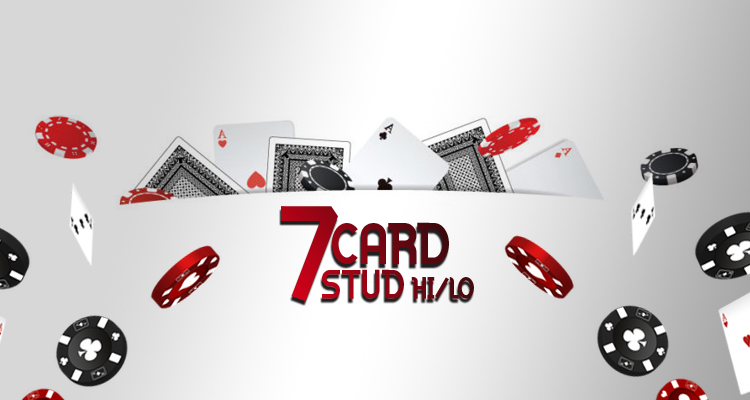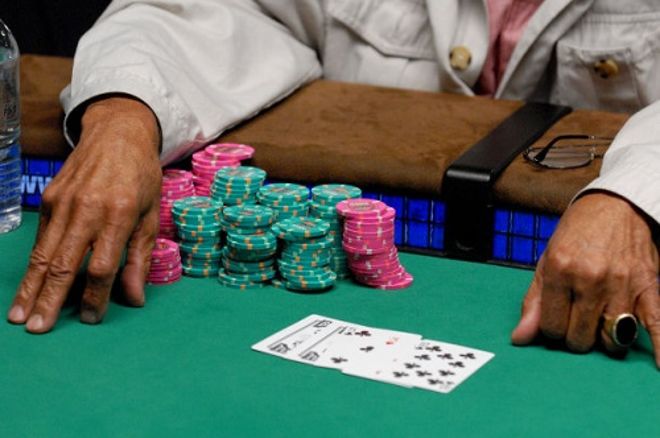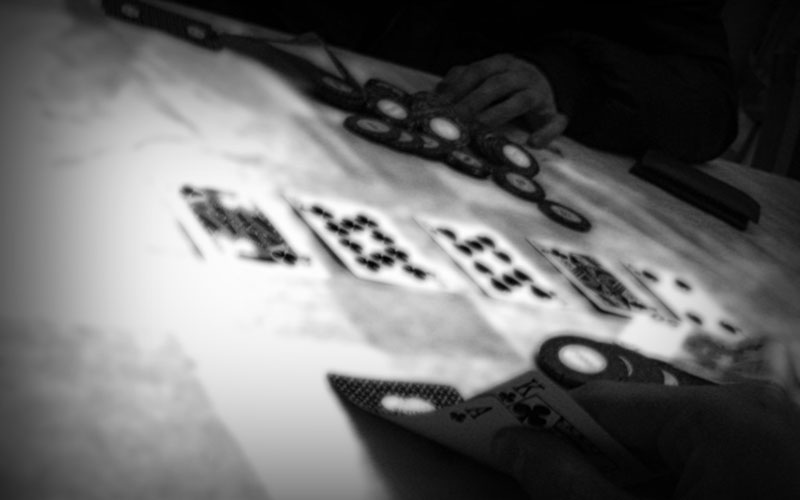“Nothing endures but change.” – Heraclitus
By far, my favorite poker game is Stud Hi-Lo (also called seven-card stud: eight or better, stud-eight, or simply eight-or-better). This game combines elements of split game poker along with stud. Like all split games, your goal is to scoop pots-not win half of a pot. Many of your opponents in stud eight do not comprehend correct play, allowing the skilled player to make money. This is the first of twelve introductory lessons on seven-card stud eight or better.
Seven Card Stud Hi/Lo is played exactly the same way as Seven Card Stud with one exception: in the showdown, the highest hand only wins half the pot while the other half is won by the best low hand. However, this is only true if a player shows down a qualifying low hand. If there is no qualifying low hand, the best high hand wins the whole pot. Stud Hi/Lo uses the ‘Ace to Five’ or ‘California’ system for ranking low hands. Straights and flushes do not count against a hand, and Aces are always low, so the best possible hand is a 'wheel': 5, 4, 3, 2, A. Stud high-low split pot is a form of seven-card stud. It is often referred to as stud high-low, stud eight or better, or stud/8. The key difference between this game and straight seven-card stud is that the highest hand and lowest hand split the pot. Seven-Card Stud and Seven-Card Stud High-Low Eight or Better (Stud-Eight) Poker The following terminology is useful for discussing starting hands in Seven-Card Stud High-Low poker. The table below defines 12 types of starting hands along with a description and an example of each.
Specifics of Stud Hi/Lo
Stud hi/lo is dealt from a standard 52-card deck. Games are usually eight-handed. A professional dealer sits at the back center of the table (a computer facsimile if you’re playing online), with the players sitting around the remainder of the table. Each player antes (a small forced bet) in front of them. The dealer then deals out the first of two down cards to each player (beginning with the one seat, the seat just to the left of the dealer), followed by the second down card, and, finally, followed by one up card. Typically, in a $10/$20 limit stud hi/lo game, the ante might be $1, with a forced bring-in of $3.
For example, player 1 has as his up-card the 2♥, player 2 has the J♦, player 3 has the 5♠, player 4 has the Q♠, player 5 has the A♣, player 6 has the 2♣, player 7 has the A♦ and player 8 has the 10♦. The lowest up-card (by suit) must bring-in (start) the action. Player 6 must bring-in the action either for the forced bet of $3 or he may complete the bet to $10. Assume he brings in the action for $3. The other players then, in turn (clockwise around the table) may either call the $3, fold, or complete the bet to $10. Assume player 7 calls the $3, players 8 and 1 fold, player 2 calls, players 3 and 4 fold, player 5 completes to $10, and players 6, 7, and 2 call. This first betting round is called third street.

The dealer will scoop the bets into the middle, burn a card, and then deal a second up card to each player left in the pot (fourth street). Let’s assume that the hands become: Player 2: J♦8♥, Player 5: A♣4♣, Player 6: 22, and Player 7: A♦9♥. Unlike seven-card stud, there is no double-bet on fourth street if there is an open pair showing. On fourth street (and all other betting rounds) the highest hand showing bets first. Thus, in our example, player 6 can check or bet $10. Assume he checks. Player 7 elects to bet $10 and player 2 folds. Player 5 can fold, call the $10 or raise to $20. Assume he raises to $20 and players 6 and 7 call.
The dealer will scoop the bets into the middle, burn a card, and then deal a third up card to each player left in the pot (fifth street). Let’s assume that the hands become:
Player 5: A♣4♣9♣, Player 6: 2♣2♠K♥, and Player 7: A♦9♥4♥. Player 6, the high hand on board, can either bet $20 or check. Player 6 checks, player 7 checks, and player 5 bets $20. The other players could raise (in increments of $20); let’s assume that only player 7 calls.
The dealer will scoop the bets into the middle, burn a card, and then deal a fourth up card to each player left in the pot (sixth street). Let’s assume that the hands become: Player 5:
A♣4♣9♣7♥ and Player 7: A♦9♥4♥7♠. When there are two equivalent high hands showing, the left-most hand (e.g. player 5) will act first. Assume player 5 bets $20 and player 7 calls.
The dealer will scoop the bets into the middle, burn a card, and then deal a third down card to each player left in the pot (seventh street). Player 5 will act first (the player who acts first on sixth street will act first on seventh street if he is still in the hand). Assume he bets and player 7 calls. Player 5 shows his hand: (A♥6♥5♦)A♣4♣9♣7♥ — one pair (Aces, with a 976 kicker), and a 7654A low. Player 7 shows his hand: (JJJ)A947 — three Jacks with an Ace and 9 as kickers, with no low. The pot is split between the two players, with Player 5 winning the low and Player 7 winning the high. If there’s an odd chip, it is given to the player winning high. As in hold’em, the winning high hand is the best five-card hand formed from each player’s seven cards. (Note: parentheses are used to indicate the down cards in stud.)
Like almost all split-pot games dealt in public casinos and cardrooms, stud hi/lo is played with an eight qualifier for low. In order to have a low, you must have five cards individually numbered eight or lower (hence the name eight or better). Straights and flushes do not count against you for low. An ace functions as the lowest possible card, a one, in determining low hands. In comparing two low hands, read the cards from the highest card to the lowest. For example, a player holding (K♦7♠3♣)5♥2♠A♦8♦ has a 7532A low, while a player holding
(Q♠Q♣4♠)2♥6♥5♦3♠ has a 65432 low. If these two players were against each other, the 65432 low would be the better low and would win the low half of the pot.
Unlike Omaha hi/lo, the majority of stud-eight hands have a low hand. Players don’t share cards, so there’s a strong likelihood that someone is dealt a low. Many stud hi/lo hands become a battle of an obvious high, an obvious low, and a not so obvious high or low.

The ability to remember cards played is very important in seven-card stud. For example, if you have four cards to a flush but almost all of the cards of your suit have been played, you may need to fold your hand.
Stud hi/lo is frequently played with an “action bet.” If a player scoops a decent-sized pot, he is required to post a third-street completion bet (if the game is $10/$20 limit, he would post $10). Players acting before the player with the “action bet” cannot complete the bet themselves-they must either call the bring-in or fold. When the action gets to the “action bet” player, he makes his automatic completion bet. The other players now get a chance to raise, call, or fold.
Stud Hi Lo Hand Rankings
There’s a dedicated group of stud hi/lo players, but the game isn’t as popular as seven-card stud, and is nowhere near as popular as hold’em. On the West Coast, stud hi/lo is more popular than seven-card stud high: yesterday, in the cardroom I frequent, there were three games of stud hi/lo but no games of seven-card stud high.
Stud hi/lo is not popular at the low limits, though (except online). It’s a shame, because it’s a relatively easy game to play, and is a very beatable game. In cardrooms, though, you’ll find many more games of low-limit stud high than stud hi/lo.
Why Play 7 Card Stud
To make money, of course. Many players have no concept that the goal is scooping pots, and will chase pots when their only chance is to win half of a pot. If you just think about this in relationship to pot odds, you should understand why this is a poor strategy.
Other reasons to play Stud hi/lo include:
- Players play far too many hands. Stud rewards patience. Starting hand selection is vital.
- If you can read players you will prosper in stud. Knowing if a player has two pair, or is just chasing a flush draw, is vital.
- If you have a good memory for the cards that have been played, you will have an advantage over many of your opponents in stud.
Why You Shouldn’t Play Stud Hi/Lo
If you want constant action, play hold’em, and bypass all forms of stud. Other reasons not to play stud hi/lo include:

The game isn’t played in your casino or cardroom.
You have a bad memory for cards. This is a huge detriment to playing stud – the cards that have been played have a tremendous impact on each hand.


Stud Hi-lo Calculator
Conclusion
Stud hi/lo is a fun game to play and can also be a quite profitable one to play. Over the next 11 lessons we will look at how to become a winning stud hi/lo player. In the next lesson, we will examine necessary traits of the winning stud hi/lo player.
Stud Hi Low
Join us on our Discord channel.